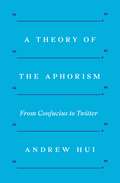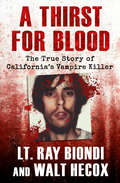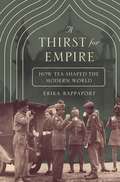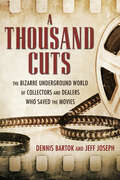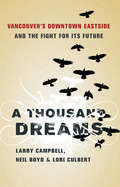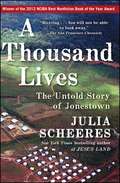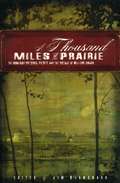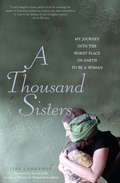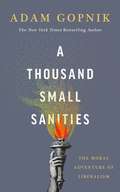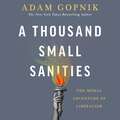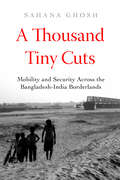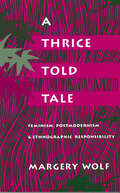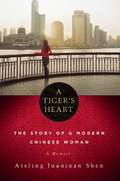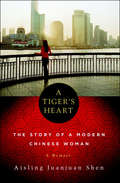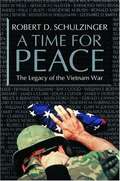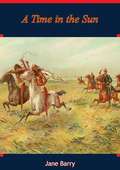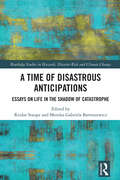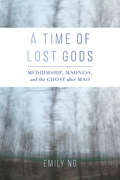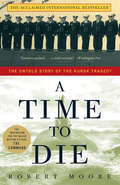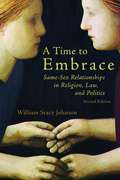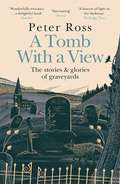- Table View
- List View
A Theory of the Aphorism: From Confucius to Twitter
by Andrew HuiAn engaging look at the aphorism, the shortest literary form, across time, languages, and culturesAphorisms—or philosophical short sayings—appear everywhere, from Confucius to Twitter, the Buddha to the Bible, Heraclitus to Nietzsche. Yet despite this ubiquity, the aphorism is the least studied literary form. What are its origins? How did it develop? How do religious or philosophical movements arise from the enigmatic sayings of charismatic leaders? And why do some of our most celebrated modern philosophers use aphoristic fragments to convey their deepest ideas? In A Theory of the Aphorism, Andrew Hui crisscrosses histories and cultures to answer these questions and more.With clarity and precision, Hui demonstrates how aphorisms—ranging from China, Greece, and biblical antiquity to the European Renaissance and nineteenth century—encompass sweeping and urgent programs of thought. Constructed as literary fragments, aphorisms open new lines of inquiry and horizons of interpretation. In this way, aphorisms have functioned as ancestors, allies, or antagonists to grand systems of philosophy.Encompassing literature, philology, and philosophy, the history of the book and the history of reading, A Theory of the Aphorism invites us to reflect anew on what it means to think deeply about this pithiest of literary forms.
A Thesaurus of African Languages: A Classified and Annotated Inventory of the Spoken Languages of Africa With an Appendix on Their Written Representation (Linguistic Surveys of Africa #1)
by Michael Mann David DalbyOriginally published in 1987, this thesaurus is concerned with the spoken languages of Africa. Languages are grouped into a relatively large number of sets and subsets within which the relationship of languages to one another is locally apparent and uncontroversial. The volume presents the languages in classified order with notes on each language, their variant names and immediate classification, and reference to the sources consulted. One section offers an exhaustive list of the languages spoken as home languages by local communities in each state, together with details of languages widely used for inter-group communication, given official recognition, or used in education or the media. There are brief phonological analyses of a broad sample of some 20 African languages and a comprehensive bibliography and language index to the whole work
A Third University Is Possible (Forerunners: Ideas First)
by la papersonA Third University is Possible unravels the intimate relationship between the more than 200 US land grant institutions, American settler colonialism, and contemporary university expansion. Author la paperson cracks open uncanny connections between Indian boarding schools, Black education, and missionary schools in Kenya; and between the Department of Homeland Security and the University of California. Central to la paperson&’s discussion is the &“scyborg,&” a decolonizing agent of technological subversion.Drawing parallels to Third Cinema and Black filmmaking assemblages, A Third University is Possible ultimately presents new ways of using language to develop a framework for hotwiring university &“machines&” to the practical work of decolonization. Forerunners: Ideas First is a thought-in-process series of breakthrough digital publications. Written between fresh ideas and finished books, Forerunners draws on scholarly work initiated in notable blogs, social media, conference plenaries, journal articles, and the synergy of academic exchange. This is gray literature publishing: where intense thinking, change, and speculation take place in scholarship.
A Thirst for Blood: The True Story of California's Vampire Killer
by Walt Hecox Lt. Ray BiondiThe &“fast-paced&” inside story of the manhunt for bloodsucking serial killer Richard Chase (Publishers Weekly). Written by the case&’s lead homicide detective, this gripping true crime account details the killing spree of one of California&’s most gruesome murderers: Richard Chase, aka &“the Vampire of Sacramento.&” In January 1978, Sacramento police found the corpse of Teresa Wallin, a loving wife and soon-to-be mother. Veteran detective Lt. Ray Biondi immediately knew the case would be unlike anything he had ever seen before. The victim&’s body was deliberately disfigured in nightmarish ways, and evidence suggested the culprit had collected large volumes of her blood. In less than a month, a two-year-old boy was missing, and two men, another woman, and a five-year-old child dead, their bodies contorted, like Wallin&’s, to fulfill the killer&’s demented sexual desires, and—most disturbingly—his taste for human blood. Previously published as The Dracula Killer, A Thirst for Blood is a riveting report of the investigation, from eyewitness testimonies to the discovery of the crime scenes to Chase&’s interrogation. Lieutenant Biondi and his coauthor, Walt Hecox, provide an unflinching look at the &“vampire killer&” and the cunning police work that finally put an end to his reign of terror. The inspiration for Investigation Discovery&’s Lore: Deadly Obsession and episodes of CSI and Criminal Minds, Chase&’s crimes continue to haunt the world generations later.
A Thirst for Empire: How Tea Shaped the Modern World
by Erika RappaportHow the global tea industry influenced the international economy and the rise of mass consumerismTea has been one of the most popular commodities in the world. Over centuries, profits from its growth and sales funded wars and fueled colonization, and its cultivation brought about massive changes—in land use, labor systems, market practices, and social hierarchies—the effects of which are with us even today. A Thirst for Empire takes a vast and in depth historical look at how men and women—through the tea industry in Europe, Asia, North America, and Africa—transformed global tastes and habits and in the process created our modern consumer society.As Erika Rappaport shows, between the seventeenth and twentieth centuries the boundaries of the tea industry and the British Empire overlapped but were never identical, and she highlights the economic, political, and cultural forces that enabled the British Empire to dominate—but never entirely control—the worldwide production, trade, and consumption of tea. Rappaport delves into how Europeans adopted, appropriated, and altered Chinese tea culture to build a widespread demand for tea in Britain and other global markets and a plantation-based economy in South Asia and Africa. Tea was among the earliest colonial industries in which merchants, planters, promoters, and retailers used imperial resources to pay for global advertising and political lobbying. The commercial model that tea inspired still exists and is vital for understanding how politics and publicity influence the international economy.An expansive and original global history of imperial tea, A Thirst for Empire demonstrates the ways that this fluid and powerful enterprise helped shape the contemporary world.
A Thousand Cuts: The Bizarre Underground World of Collectors and Dealers Who Saved the Movies
by Dennis Bartok Jeff JosephA Thousand Cuts is a candid exploration of one of America's strangest and most quickly vanishing subcultures. It is about the death of physical film in the digital era and about a paranoid, secretive, eccentric, and sometimes obsessive group of film-mad collectors who made movies and their projection a private religion in the time before DVDs and Blu-rays. The book includes the stories of film historian/critic Leonard Maltin, TCM host Robert Osborne discussing Rock Hudson's secret 1970s film vault, RoboCop producer Jon Davison dropping acid and screening King Kong with Jefferson Airplane at the Fillmore East, and Academy Award-winning film historian Kevin Brownlow recounting his decades-long quest to restore the 1927 Napoleon. Other lesser-known but equally fascinating subjects include one-legged former Broadway dancer Tony Turano, who lives in a Norma Desmond-like world of decaying movie memories, and notorious film pirate Al Beardsley, one of the men responsible for putting O. J. Simpson behind bars. Authors Dennis Bartok and Jeff Joseph examine one of the least-known episodes in modern legal history: the FBI's and Justice Department's campaign to harass, intimidate, and arrest film dealers and collectors in the early 1970s. Many of those persecuted were gay men. Victims included Planet of the Apes star Roddy McDowall, who was arrested in 1974 for film collecting and forced to name names of fellow collectors, including Rock Hudson and Mel Tormé. A Thousand Cuts explores the obsessions of the colorful individuals who created their own screening rooms, spent vast sums, negotiated underground networks, and even risked legal jeopardy to pursue their passion for real, physical film.
A Thousand Days In Venice: An Unexpected Romance
by Marlena De BlasiFernando first sees Marlena across the Piazza San Marco and falls in love from afar. When he sees her again in a Venice a year later, he knows it is fate. He knows little English; she, a divorced American chef traveling through Italy, speaks only food-based Italian. Marlena thought she was done with romantic love, incapable of intimacy. Yet within months of their first meeting, she has quit her job, sold her house in St. Louis, kissed her two grown sons good-bye, and moved to Venice to marry "the stranger," as she calls Fernando. This deliciously satisfying memoir is filled with the foods and flavors of Italy and peppered with culinary observations and recipes. But the main course here is an enchanting true story about a woman who falls in love with both a man and a city, and finally finds the home she didn't even know she was missing.
A Thousand Dreams: Vancouver's Downtown Eastside and the Fight for Its Future
by Neil Boyd Larry Campbell Lori CulbertIn this mix of history, journalism, political analysis, and first-person accounts, former chief coroner and Vancouver mayor Larry Campbell, renowned criminologist Neil Boyd, and investigative journalist Lori Culbert, offer a portrait of one of North America's poorest, most drug-challenged neighbourhoods: Vancouver's Downtown Eastside.<P><P>A Thousand Dreams raises provocative questions about the challenges confronting not only Vancouver's Downtown Eastside but also all of North America's major cities and offers concrete, urgently needed solutions, including:Continued support for Insite, the safe injection siteDecriminalization of prostitution and drugsThe transfer of addiction services to the Health Ministry, allowing detox into the medical systemMore government-funded SROs and more affordable social housing
A Thousand Lives: The Untold Story of Hope, Deception, and Survival at Jonestown
by Julia ScheeresIn 1954, a pastor named Jim Jones opened a church in Indianapolis called Peoples Temple Full Gospel Church. He was a charismatic preacher with idealistic beliefs, and he quickly filled his pews with an audience eager to hear his sermons on social justice. As Jones’s behavior became erratic and his message more ominous, his followers leaned on each other to recapture the sense of equality that had drawn them to his church. But even as the congregation thrived, Jones made it increasingly difficult for members to leave. By the time Jones moved his congregation to a remote jungle in Guyana and the US government began to investigate allegations of abuse and false imprisonment in Jonestown, it was too late. A Thousand Lives is the story of Jonestown as it has never been told. New York Times bestselling author Julia Scheeres drew from tens of thousands of recently declassified FBI documents and audiotapes, as well as rare videos and interviews, to piece together an unprecedented and compelling history of the doomed camp, focusing on the people who lived there. The people who built Jonestown wanted to forge a better life for themselves and their children. In South America, however, they found themselves trapped in Jonestown and cut off from the outside world as their leader goaded them toward committing “revolutionary suicide” and deprived them of food, sleep, and hope. Vividly written and impossible to forget, A Thousand Lives is a story of blind loyalty and daring escapes, of corrupted ideals and senseless, haunting loss.
A Thousand Miles of Prairie: The Manitoba Historical Society and the History of Western Canada
by Jim BlanchardA Thousand Miles of Prairie is a fascinating look at Manitoba's early boom years (1880-1910) through the eyes and words of some of the most interesting personalities of early Winnipeg. This collection brings together 14 pieces from the first decades of the Manitoba Historical Society, when its lectures were attended by the provinceís political and cultural elite. Jim Blanchard has chosen selections that give us a vivid taste of the diversity of intellectual life in turn of the century Manitoba. Besides writings by early historians such as George Bryce and Charles Bell, he includes a paper by the young Ernest Thompson Seton, who writes about his attempts to raise prairie chickens. There is also a description of the last passenger pigeons found in Manitoba. The collection includes lively personal reminscences, such as Gilbert McMicken, Canada's first spymaster, talking about foiling a Fenian raid on Winnipeg, and Archbishop Samuel Matheson, who tells about his boyhood adventures in the great Red River floods of the 1860s.
A Thousand Shards of Glass
by Michael KatakisA visceral and eviscerating lament for the USA, the country Katakis loved but can no longer bear to live in.Once upon a time, Michael Katakis lived in a place of big dreams, bright colours and sleight of hand. That place was America. One night, travelling where those who live within illusions should never go, he stared into the darkness and glimpsed a faded flag where shadows gathered, revealing another America. It was a broken place, bred from fear and distrust - a thousand shards of glass - filled with a people who long ago had given away all that was precious; a people who had been sold, for so long, a foreign betrayal that finally came from within, and for nothing more than a handful of silver. These essays, letters and journal entries were written as a farewell to the country Michael loves still, and to the wife he knew as his 'True North'. A powerful and personal polemic, A Thousand Shards of Glass is Michael's appeal to his fellow citizens to change their course; a cautionary tale to those around the world who idealise an America that never was; and, crucially, a glimpse beyond the myth, to a country whose best days could still lie ahead.
A Thousand Sisters: My Journey into the Worst Place on Earth to Be a Woman
by Zainab Salbi Lisa J ShannonLisa J. Shannon had a good life--a successful business, a fiancé, a home, and security. Then, one day in 2005, an episode of Oprah changed all that. The show focused on women in Congo, the worst place on earth to be a woman. She was awakened to the atrocities there--millions dead, women raped and tortured daily, and children dying in shocking numbers. Shannon felt called to do something. And she did. A Thousand Sisters is her inspiring memoir. She raised money to sponsor Congolese women, beginning with one solo 30-mile run, and then founded a national organization, Run for Congo Women. The book chronicles her journey to the Congo to meet the women her run sponsored, and shares their incredible stories. What begins as grassroots activism forces Shannon to confront herself and her life, and learn lessons of survival, fear, gratitude, and immense love from the women of Africa.
A Thousand Small Sanities: The Moral Adventure of Liberalism
by Adam Gopnik'WITTY, HUMANE, LEARNED' NEW YORK TIMESThe New York Times-bestselling author offers a stirring defence of liberalism against the dogmatisms of our timeNot since the early twentieth century has liberalism, and liberals, been under such relentless attack, from both right and left. The crisis of democracy in our era has produced a crisis of faith in liberal institutions and, even worse, in liberal thought.A Thousand Small Sanities is a manifesto rooted in the lives of people who invented and extended the liberal tradition. Taking us from Montaigne to Mill, and from Middlemarch to the civil rights movement, Adam Gopnik argues that liberalism is not a form of centrism, nor simply another word for free markets, nor merely a term denoting a set of rights. It is something far more ambitious: the search for radical change by humane measures. Gopnik shows us why liberalism is one of the great moral adventures in human history--and why, in an age of autocracy, our lives may depend on its continuation.
A Thousand Small Sanities: The Moral Adventure of Liberalism
by Adam Gopnik'WITTY, HUMANE, LEARNED' NEW YORK TIMESThe New York Times-bestselling author offers a stirring defence of liberalism against the dogmatisms of our timeNot since the early twentieth century has liberalism, and liberals, been under such relentless attack, from both right and left. The crisis of democracy in our era has produced a crisis of faith in liberal institutions and, even worse, in liberal thought.A Thousand Small Sanities is a manifesto rooted in the lives of people who invented and extended the liberal tradition. Taking us from Montaigne to Mill, and from Middlemarch to the civil rights movement, Adam Gopnik argues that liberalism is not a form of centrism, nor simply another word for free markets, nor merely a term denoting a set of rights. It is something far more ambitious: the search for radical change by humane measures. Gopnik shows us why liberalism is one of the great moral adventures in human history--and why, in an age of autocracy, our lives may depend on its continuation.(P)2019 Hachette Audio
A Thousand Tiny Cuts: Mobility and Security across the Bangladesh-India Borderlands (Atelier: Ethnographic Inquiry in the Twenty-First Century #10)
by Sahana GhoshA Thousand Tiny Cuts chronicles the slow transformation of a connected region into national borderlands. Drawing on a decade of fieldwork in northern Bangladesh and eastern India, Sahana Ghosh shows the foundational place of gender and sexuality in the making and management of threat in relation to mobility. Rather than focusing solely on border fences and border crossings, she demonstrates that bordering reorders relations of value. The cost of militarization across this ostensibly "friendly" border is devaluation—of agrarian land and crops, of borderland youth undesirable as brides and grooms in their respective national hinterlands, of regional infrastructures now disconnected, and of social and physical geographies disordered by surveillance. Through a textured ethnography of the gendered political economy of mobility across postcolonial borderlands in South Asia, this ambitious book challenges anthropological understandings of the violence of bordering, migration and citizenship, and transnational inequalities that are based on Euro-American borders and security regimes.
A Thrice-Told Tale: Feminism, Postmodernism, and Ethnographic Responsibility
by Margery WolfA Thrice-Told Tale is one ethnographer's imaginative and powerful response to the methodological issues raised by feminist and postmodernist critics of traditional ethnography. The author, a feminist anthropologist, uses three texts developed out of her research in Taiwan--a piece of fiction, anthropological fieldnotes, and a social science article--to explore some of these criticisms. Each text takes a different perspective, is written in a different style, and has different "outcomes," yet all three involve the same fascinating set of events. A young mother began to behave in a decidedly abherrant, perhaps suicidal manner, and opinion in her village was sharply divided over the reason. Was she becoming a shaman, posessed by a god? Was she deranged, in need of physical restraint, drugs, and hospitalization? Or was she being cynically manipulated by her ne'er-do-well husband to elicit sympathy and money from her neighbors? In the end, the woman was taken away from the area to her mother's house. For some villagers, this settled the matter; for others the debate over her behavior was probably never truly resolved. The first text is a short story written shortly after the incident, which occurred almost thrity years ago; the second text is a copy of the fieldnotes collected about the events covered in the short story; the third text is an article published in 1990 in American Ethnologist that analyzes the incident from the author's current perspective. Following each text is a Commentary in which the author discusses such topics as experimental ethnography, polyvocality, authorial presence and control, reflexivity, and some of the differences between fiction and ethnography. The three texts are framed by two chapters in which the author discusses the genereal problems posed by feminist and postmodernist critics of ethnography and presents her personal exploration of these issues in an argument that is strongly self-reflexive and theoretically rigorous. She considers some feminist concerns over colonial research methods and takes issues with the insistence of some feminists tha the topics of ethnographic research be set by those who are studied. The book concludes with a plea for ethnographic responsibility based on a less academic and more practical perspective.
A Tiger's Hear
by Aisling Juanjuan ShenBorn to illiterate peasants, Aisling Juanjuan Shen was the first in her village to go to college. Assigned to a low-paying government job, she left for southern China to find success. Her story embodies the changes in China in recent decades.
A Tiger's Heart: The Story of a Modern Chinese Woman
by Aisling Juanjuan ShenThis remarkable true story of a Chinese peasant girl&’s unlikely rise to success is &“like a suspense novel . . . Impossible to put down&”(Library Journal, starred review). Aisling Juanjuan Shen was born to illiterate peasants in a tiny farming hamlet in China&’s Yangtze Delta in 1974. Pronounced useless by her parents because she wasn&’t good at planting rice, she became the first person from her village ever to attend college. After graduating with a teaching degree, the government assigned her to a remote and low-paying job that she was expected to hold for the rest of her life. But she wasn&’t satisfied—and she bought her way out of her secure position and left for the special economic zones of southern China, in search of happiness and success in the business world, eventually immigrating to the United States. In this memoir, Aisling chronicles her rise from rural poverty to a successful career, illustrating the massive economic and social changes that have taken place in China over the past several decades. Her story is emblematic of a new generation of Chinese women who are leaving the rice paddies and government jobs in order to enter the free market and determine the course of their own lives.
A Time for Peace: The Legacy of the Vietnam War
by Robert D. SchulzingerA Time for Peace: The Legacy of the Vietnam War tells the story of how the American War in Vietnam has been remembered and the effects different memories have had on current events. This book is divided into four parts: Part I, "International Affairs", Part II, "Veterans and Vietnamese Americans", Part III, "Cultural Legacies", and Part IV, "Conclusion: Political Echoes of a War".
A Time in the Sun: An Epic Novel Of The Apaches And The Struggle For Arizona
by Jane BarryA major novel of the Indian wars in the far West, told from both points of view—the Apache’s and the white man’s.Anna Stillman was on her way to Tucson to marry Lieutenant Linus Degnan, the son of the commandant of the U.S. fort there, when she was captured by an Apache raiding party. It was 1870, and the Apaches were making a fierce last stand against the white men who were driving them from their land.The Degnans, father and son, soon realized that any attempt to rescue Anna by force would endanger her life, and so they sent Shafter, an ex-Confederate whom the Indians trusted, to try to ransom her. Victorio, leader of the Mimbreños tribe, willingly set a price for the release of the Mexican girl who had been Anna’s traveling companion, but was unwilling to ransom Anna.Greatly disturbed by the Mexican girl’s report that Anna was living with an Apache brave, Linus and his father made every effort to get her back, only to discover that she no longer wanted to be rescued.Jane Barry develops her characters in depth—Anna, who could not avoid hurting the man she had always intended to marry; Joaquin, who had cast his lot with the Apaches when he found that he was not accepted in the white man’s world; Linus, whose struggle to save Anna made a man of him; and Shafter, who tried to be a friend to both Joaquin and Linus.Most of the Apache chiefs and some of the Americans who figure in the book are historical personages. Mrs. Barry’s thorough research has enabled her to bring the Apache civilization to life in vivid detail. A TIME IN THE SUN is a powerful novel about the conflicts experienced by people at odds with one another caught between two ways of life.
A Time of Disastrous Anticipations: Essays on Life in the Shadow of Catastrophe (Routledge Studies in Hazards, Disaster Risk and Climate Change)
by Reidar Staupe Monika Gabriela BartoszewiczThis book explores the pervasive anticipation of catastrophe in contemporary society, examining how temporal expectations shape personal and collective experiences and influence our perspectives and responses.A Time of Disastrous Anticipations highlights the role of anticipation in shaping societal narratives, exploring strategies for redefining responses to catastrophic imaginaries. Through a combination of theoretical insights with practical examples, it offers a comprehensive view of anticipation’s impact in contemporary society. The vista of disastrous anticipations reveals that catastrophe is not so much a matter out of place, but primarily a matter out of time.Targeted at scholars, students, and professionals in sociology, disaster studies, and public policy, this book is also valuable for policymakers and practitioners interested in understanding the societal dimension of disaster anticipation.
A Time of Lost Gods: Mediumship, Madness, and the Ghost after Mao
by Emily NgTraversing visible and invisible realms, A Time of Lost Gods attends to profound rereadings of politics, religion, and madness in the cosmic accounts of spirit mediumship. Drawing on research across a temple, a psychiatric unit, and the home altars of spirit mediums in a rural county of China’s Central Plain, it asks: What ghostly forms emerge after the death of Mao and the so-called end of history? The story of religion in China since the market reforms of the late 1970s is often told through its destruction under Mao and relative flourishing thereafter. Here, those who engage in mediumship offer a different history of the present. They approach Mao’s reign not simply as an earthly secular rule, but an exceptional interval of divine sovereignty, after which the cosmos collapsed into chaos. Caught between a fading era and an ever-receding horizon, those "left behind" by labor outmigration refigure the evacuated hometown as an ethical-spiritual center to come, amidst a proliferation of madness-inducing spirits. Following pronouncements of China’s rise, and in the wake of what Chinese intellectuals termed semicolonialism, the stories here tell of spirit mediums, patients, and psychiatrists caught in a shared dilemma, in a time when gods have lost their way.
A Time to Die: The Kursk Disaster
by Robert MooreAt 10:30am on Saturday August 12, 2000, two massive explosions in a rapid succession shook the icy Arctic waters of the Barents Sea. The Kursk, one of the largest and most technologically advanced nuclear subs in the world, carrying a crew of 118 Russian sailors, had suffered a major, unexplained accident, and rapidly crashed to the ocean floor. Most of us can still remember how news of this terrible accident was reported around the world, and the agonising tension of the days when the doomed crew waited for rescue, the Russians seemed to turn away all international offers to help, until it was too late. Robert Moore, the former Moscow Correspondent of ITN, and now their Foreign Affairs editor, has written a thrilling and authoritative investigative book on this tragedy. He has talked to everyone from the families of the crew, the Russian officials, the international rescue teams and the US submarine crews who were monitoring the Kursk's movements. A TIME TO DIE not only recreates the tragic and terrifying final moments of the submarine and its crew, but also explores the events leading up to it and the political, social and environmental issued raised by the catastrophe. But above all, this is a human story, how the Kursk's crew was doomed, how their surviving families fought to learn the truth about their fate, about the British civilian North Sea divers who tried to assist in the rescue mission; told in a narrative with all the excitement, immediacy and emotional intensity, of bestsellers such as A PERFECT STORM and BLACK HAWK DOWN.
A Time to Embrace: Same-Sex Relationships in Religion, Law, and Politics, 2nd edition
by William Stacy JohnsonIn A Time to Embrace William Stacy Johnson brilliantly analyzes the religious, legal, and political debates about gay marriage, civil unions, and committed gay couples. This new edition includes updates that reflect the many changes in laws pertaining to civil unions / same-sex marriage since 2006.
A Tomb With a View – The Stories & Glories of Graveyards: A Financial Times Book of the Year
by Peter RossA FINANCIAL TIMES, I PAPER AND STYLIST BOOK OF THE YEAR'In his absorbing book about the lost and the gone, Peter Ross takes us from Flanders Fields to Milltown to Kensal Green, to melancholy islands and surprisingly lively ossuaries . . . a considered and moving book on the timely subject of how the dead are remembered, and how they go on working below the surface of our lives.' - Hilary Mantel'Ross is a wonderfully evocative writer, deftly capturing a sense of place and history, while bringing a deep humanity to his subject. He has written a delightful book.' - The Guardian'The pages burst with life and anecdote while also examining our relationship with remembrance.' - Financial Times (best travel books of 2020)'Among the year's most surprising "sleeper" successes is A Tomb with a View. In a year with so much death, it may have initially seemed a hard sell, but the author's humanity has instead acted as a beacon of light in the darkness.' - The Sunday Times'Fascinating . . . Ross makes a likeably idiosyncratic guide and one finishes the book feeling strangely optimistic about the inevitable.' - The Observer'Ross has written [a] lively elegy to Britain's best burial grounds.' - Evening Standard (*Best New Books of Autumn 2020*)'One of the non-fiction books of the year.' - The i paper (*2020 Best Books for Christmas*)'Brilliant.' - Stylist (*Best Christmas books for Christmas 2020*)'Never has a book about death been so full of life. James Joyce and Charles Dickens would've loved it - a book that reveals much gravity in the humour and many stories in the graveyard. It also reveals Peter Ross to be among the best non-fiction writers in the country.' - Andrew O'HaganFor readers of The Salt Path, Mudlarking, Ghostland, Kathleen Jamie and Robert Macfarlane. Enter a grave new world of fascination and delight as award-winning writer Peter Ross uncovers the stories and glories of graveyards. Who are London's outcast dead and why is David Bowie their guardian angel? What is the remarkable truth about Phoebe Hessel, who disguised herself as a man to fight alongside her sweetheart, and went on to live in the reigns of five monarchs? Why is a Bristol cemetery the perfect wedding venue for goths? All of these sorrowful mysteries - and many more - are answered in A Tomb With A View, a book for anyone who has ever wandered through a field of crooked headstones and wondered about the lives and deaths of those who lie beneath.
